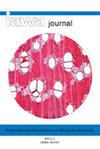地中海环孔栎的年际密度波动表明夏季湿润条件和冠层活动增强
IF 1.4
3区 农林科学
Q2 FORESTRY
引用次数: 0
摘要
地中海环孔栎树种晚木年际密度波动的气候意义和生态系统意义尚不完全清楚。为了解决这一问题,我们研究了地中海栎(Quercus faginea)径向生长和晚木iadf的气候驱动因素,以及它们是否与归一化植被指数(NDVI)记录的冠层盖度和绿度增加相关。IADFs形成于晚木中后期,以成排的薄壁细胞为特征。1999年和2014年期间,这种iadf并不常见,仅在30-50%的采样树木中存在,这两个年份的特征都是7月底和8月初的高降水。iadf的形成与夏季湿润条件的关系不同于促进荞麦年生长的条件、冬春湿润条件和夏季低温条件。IADFs的形成与8月NDVI值呈正相关,表明林冠绿度与次生生长恢复呈对应关系。我们得出结论,黑桫椤晚木iadf是罕见的夏末湿润条件和冠层活动增强的有力代表,反映了8月NDVI值的增加。进一步监测沿气候梯度的其他地中海硬木的木质学,建议从机制上解释季节性干旱生物群系中IADF的产生。本文章由计算机程序翻译,如有差异,请以英文原文为准。
Latewood intra-annual density fluctuations indicate wet summer conditions and enhanced canopy activity in a Mediterranean ring-porous oak
Summary The climatic significance and ecosystem implications of latewood intra-annual density fluctuations (IADFs) are still not fully understood in Mediterranean ring-porous oak species. To solve this issue, we investigated: (i) the climate drivers of radial growth and latewood IADFs in the Mediterranean oak Quercus faginea , and (ii) whether they were correlated to increased canopy cover and greenness as recorded by the Normalized Difference Vegetation Index (NDVI). IADFs were formed in the mid to late latewood and they were characterized by rows of parenchyma cells. Such IADFs were uncommon and only present in 30–50% of sampled trees during 1999 and 2014, both years characterized by high precipitation in late July and early August. This relationship between IADFs formation and summer wet conditions differed from the conditions that enhance Q. faginea annual growth, wet winter-spring conditions, and low summer temperatures. Furthermore, IADFs formation showed a positive relationship with August NDVI values, indicating a correspondence of canopy greenness with secondary growth reactivation. We conclude that latewood IADFs in Q. faginea are a robust proxy of rare late-summer wet conditions and enhanced canopy activity as reflected by increased August NDVI values. Further monitoring of xylogenesis in other Mediterranean hardwoods along climatic gradients is suggested to mechanistically explain IADF production in seasonally dry biomes.
求助全文
通过发布文献求助,成功后即可免费获取论文全文。
去求助
来源期刊

IAWA Journal
农林科学-林学
CiteScore
3.40
自引率
15.80%
发文量
26
审稿时长
>36 weeks
期刊介绍:
The IAWA Journal is the only international periodical fully devoted to structure, function, identification and utilisation of wood and bark in trees, shrubs, lianas, palms, bamboo and herbs. Many papers are of a multidisciplinary nature, linking
 求助内容:
求助内容: 应助结果提醒方式:
应助结果提醒方式:


